
The Asclepiadoideae are a subfamily of plants in the family Apocynaceae. Formerly, they were treated as a separate family under the name Asclepiadaceae, e.g. by APG II, and known as the milkweed family.

Sphaeralcea is a genus of flowering plants in the mallow family (Malvaceae). There are about 40-60 species, including annuals, perennials, and shrubs. Most originate in the drier regions of North America, with some known from South America. They are commonly known as globemallows, globe mallows, false mallows or falsemallows. The name of the genus is derived from the Greek words σφαῖρα (sphaira), meaning "sphere," and αλκεα (alkea), meaning "mallow."
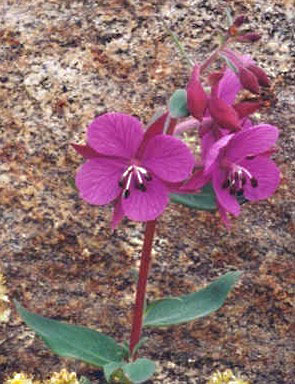
The Onagraceae are a family of flowering plants known as the willowherb family or evening primrose family. They include about 650 species of herbs, shrubs, and trees in 17 genera. The family is widespread, occurring on every continent from boreal to tropical regions.

Parkinsonia, also Cercidium, is a genus of flowering plants in the pea family, Fabaceae. It contains about 12 species that are native to semi-desert regions of Africa and the Americas. The name of the genus honors English apothecary and botanist John Parkinson (1567–1650).

Adelieae is a tribe of the subfamily Acalyphoideae, under the family Euphorbiaceae. It comprises 5 genera.
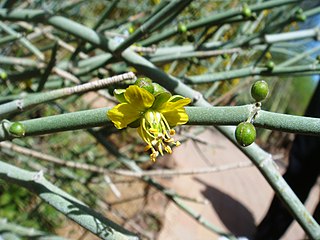
Bulnesia is a genus of flowering plants in the caltrop family, Zygophyllaceae. The wood of some – particularly B. arborea and B. sarmientoi – is traded as verawood or "lignum vitae". They are close relatives of the "true" lignum vitae trees of genus Guaiacum.

Brosimum is a genus of plants in the family Moraceae, native to tropical regions of the Americas.

Pisonia is a genus of flowering plants in the four o'clock flower family, Nyctaginaceae. It was named for Dutch physician and naturalist Willem Piso (1611–1678). Certain species in this genus are known as catchbirdtrees, birdcatcher trees or birdlime trees because they catch birds. The sticky seeds are postulated to be an adaptation of some island species that ensures the dispersal of seeds between islands by attaching them to birds, and also allows the enriching of coralline sands. These island species include P. brunoniana of Australasia and Polynesia and P. umbellifera, which is widespread in the tropical Indo-Pacific region.

Bourreria is a genus of flowering plants in the borage family, Boraginaceae. Members of the genus are commonly known as strongbark or strongback. The generic name was chosen by Patrick Browne to honour German pharmacist Johann Ambrosius Beurer. The genus is native to the Americas, where species are distributed from Mexico to northern South America, and in the Caribbean and Florida in the United States. The center of diversity is in the Caribbean, Central America, and Mexico.

Schenkia sebaeoides, known as ʻĀwiwi in Hawaiian and lavaslope centaury in English, is a rare species of flowering plant. It is endemic to low shrublands in the state of Hawaiʻi in the United States. It is present on the islands of Kauai, Oahu, Lanai, Molokai, and Maui. At the time it was added to the endangered species list of the United States in 1991 it was known from seven populations for a total of fewer than 1000 individuals. It is threatened by habitat loss.

Forestiera is a genus of flowering plants in the olive family, Oleaceae. Members of the genus are often called swampprivets. Most are shrubs.
Gyminda is a genus of flowering plants in the family Celastraceae. It includes four species native to Mexico, Central America, Florida, and the Caribbean Islands.
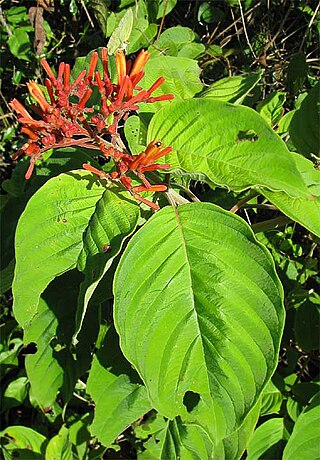
Hamelia is a genus of flowering plants in the coffee family, Rubiaceae. The name honors French botanist Henri-Louis Duhamel du Monceau (1700–1782).
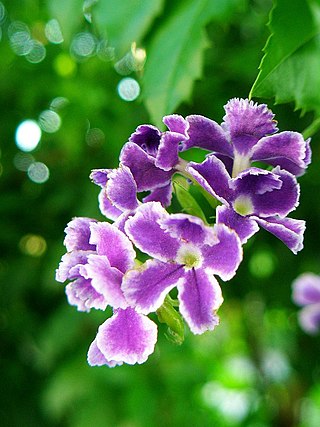
Duranta is a genus of flowering plants in the verbena family, Verbenaceae. It contains 17 species of shrubs and small trees that are native from southern Florida to Mexico and South America. They are commonly cultivated as hedges and ornamental plants.

Heteranthera is a genus of aquatic plants in the water hyacinth family, Pontederiaceae, known generally as mud plantains. Species of this genus are native to tropical and subtropical America and Africa. They live in the water or in wet soils. They produce leaves on long petioles and some are cultivated for their attractive flowers. Leaves are of two types - linear and submerged or orbicular and floating. Some species have cleistogamic flowers.

Chromolaena is a genus of about 165 species of perennials and shrubs in the family Asteraceae. The name is derived from the Greek words χρῶμα (khrôma), meaning "color", and χλαῑνα (khlaīna) or λαῑνα (laīna) meaning "cloak". It refers to the colored phyllaries of some species. Members of the genus are native to the Americas, from the southern United States to South America. One species, Chromolaena odorata, has been introduced to many parts of the world where it is considered a weed.

Chrysophylloideae is a subfamily of flowering plants in the chicle family, Sapotaceae.

Metopium or poisonwood is a genus of flowering plants in the sumac family, Anacardiaceae. They are dioecious trees with poisonous sap that can induce contact dermatitis.
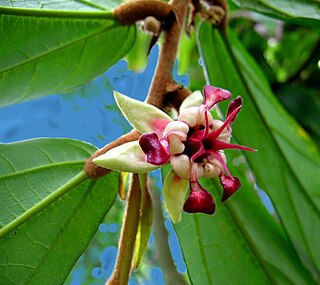
Byttnerioideae is a subfamily of the flowering plant family Malvaceae.

Zeltnera is a genus of flowering plants in the gentian family. It was erected in 2004 when the genus Centaurium was split. Genetic analysis revealed that Centaurium was polyphyletic, made up of plants that could be grouped into four clades. Each became a genus. Centaurium remained, but it is now limited to the Eurasian species. The Mexican species now belong to genus Gyrandra, and the Mediterranean and Australian plants are in genus Schenkia. The new name Zeltnera was given to this genus, which contains most of the North American centauries. There are about 25 species.



















